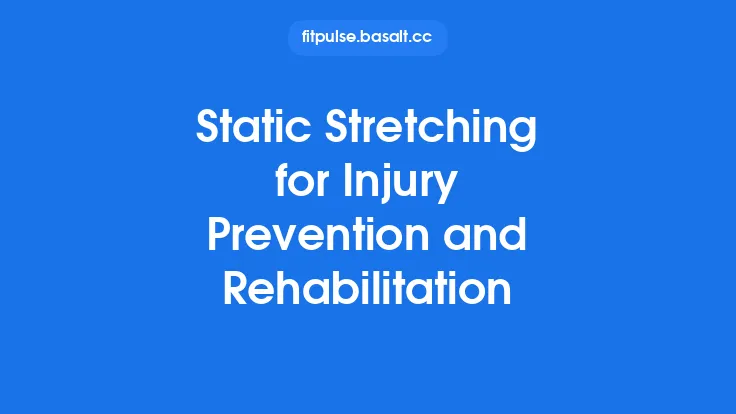In the world of combat sports, the line between peak performance and injury can be razor‑thin. Practitioners constantly push the limits of speed, power, and endurance, exposing joints, muscles, and connective tissues to repetitive high‑impact forces. While occasional bruises are part of the game, many injuries can be mitigated—or even avoided—through systematic prevention strategies and evidence‑based rehabilitation protocols. This article delves into the most frequently encountered martial‑arts ailments, outlines the core principles that keep athletes healthy, and provides step‑by‑step rehab frameworks that guide a safe return to training and competition.
Common Martial Arts Injuries: Overview
| Injury Type | Typical Mechanism | Structures Involved | Typical Symptoms |
|---|---|---|---|
| Ankle sprain | Sudden inversion/eversion during footwork or low kicks | Lateral ligaments (ATFL, CFL) | Pain, swelling, instability |
| Knee ligament strain | Pivoting, sudden deceleration, or checking a kick | ACL, MCL, PCL | Instability, “giving way,” swelling |
| Shoulder impingement/rotator cuff tendinopathy | Repetitive overhead strikes, clinch work | Supraspinatus, infraspinatus, subacromial space | Pain on elevation, weakness |
| Wrist sprain/strain | Blocking, grappling, or striking from a low stance | Scaphoid, lunate, TFCC | Pain on weight‑bearing, reduced range |
| Low back strain | Repeated twisting, hyperextension, or heavy lifts | Lumbar paraspinals, intervertebral discs | Dull ache, limited flexion/extension |
| Hand fractures (metacarpal, phalangeal) | Direct impact from punches or blocks | Metacarpal shafts, phalangeal joints | Localized pain, swelling, deformity |
| Shin splints (medial tibial stress syndrome) | Repetitive foot‑to‑ground impact in footwork | Tibial periosteum | Diffuse anterior shin pain |
| Achilles tendinopathy | Repeated explosive push‑offs in kicks | Achilles tendon | Stiffness, pain at the heel‑calf junction |
| Patellar tendinopathy | Frequent jumping or rapid knee extension | Patellar tendon | Pain just below the kneecap, especially on loading |
Understanding the biomechanics behind each injury is the first step toward targeted prevention and rehabilitation.
Principles of Injury Prevention in Combat Training
- Progressive Load Management
Incrementally increase volume, intensity, and technical complexity. Sudden spikes in training load are a primary risk factor for soft‑tissue overload.
- Technique Fidelity
Proper execution of strikes, footwork, and grappling entries distributes forces evenly across musculoskeletal structures, reducing focal stress.
- Joint‑Specific Conditioning
Strengthen the dynamic stabilizers (e.g., rotator cuff, hip abductors, ankle evertors) that protect the primary movers during high‑velocity actions.
- Balanced Muscular Development
Counteract the repetitive nature of combat drills by incorporating antagonistic strengthening (e.g., posterior chain work to offset anterior striking dominance).
- Adequate Recovery Intervals
Schedule micro‑rest days and deload weeks to allow tissue remodeling and neural recovery.
- Equipment and Surface Considerations
Use appropriate padding, mats, and footwear that absorb impact without compromising proprioception.
- Regular Screening
Conduct periodic functional movement assessments and joint stability tests to identify asymmetries before they manifest as injuries.
Prehabilitation: Building Resilience Before Injury
Prehab programs are proactive, low‑intensity regimens designed to fortify vulnerable structures. Core components include:
- Proprioceptive Drills – Single‑leg balance on unstable platforms, wobble‑board rotations, and closed‑chain kinetic chain exercises improve joint position sense.
- Dynamic Stretch‑Mobilization – Controlled, rhythmic movements that increase tissue elasticity without static over‑stretching.
- Isometric Activation – Holding positions (e.g., wall sits, plank variations) at mid‑range to recruit stabilizing fibers without excessive joint loading.
- Eccentric Strengthening – Slow, controlled lengthening of muscles (e.g., Nordic hamstring curls, eccentric calf raises) enhances tendon resilience.
Integrating these sessions 2–3 times per week, especially during off‑season or low‑intensity phases, can dramatically lower injury incidence.
Acute Management: Immediate Steps After an Injury
When an injury occurs, the first 48–72 hours are critical for limiting secondary damage. The widely accepted PRICE protocol (Protection, Rest, Ice, Compression, Elevation) remains the cornerstone, with a few modern refinements:
- Protection – Immobilize the injured segment using braces, splints, or taping to prevent further strain.
- Rest – Cease all aggravating activities; avoid passive stretching that may exacerbate micro‑tears.
- Ice – Apply 10–15 minutes of cold therapy every 2–3 hours; consider contrast therapy (alternating cold and heat) after the initial swelling subsides.
- Compression – Elastic bandages or pneumatic compression devices help control edema.
- Elevation – Keep the limb above heart level when possible to facilitate venous return.
If pain, swelling, or functional loss persists beyond 48 hours, a professional evaluation (e.g., imaging, orthopedic consultation) is warranted.
Rehabilitation Phases and Protocols
Effective rehab follows a staged progression, each with clear objectives and criteria for advancement.
Phase I – Protection & Pain Management
- Goal: Minimize inflammation, protect structures, and maintain baseline mobility.
- Interventions: PRICE, gentle passive range‑of‑motion (PROM) within pain‑free limits, isometric contractions at low intensity (10–20 % MVIC), and neuromuscular electrical stimulation (NMES) for muscle activation.
Phase II – Restoring Range of Motion & Activation
- Goal: Re‑establish full, pain‑free joint motion and re‑activate surrounding musculature.
- Interventions:
- Active Assisted ROM (AAROM) progressing to Active ROM (AROM).
- Joint mobilizations (grade I–II) performed by a therapist.
- Low‑load isotonic exercises (e.g., body‑weight squats, wall push‑ups) emphasizing proper alignment.
Phase III – Strength & Functional Reintegration
- Goal: Build tissue tolerance, restore strength, and re‑introduce sport‑specific movement patterns.
- Interventions:
- Progressive resistance training (3–5 % weekly load increase).
- Closed‑chain kinetic chain drills (e.g., lunges, single‑leg deadlifts).
- Plyometric introductions (light hops, medicine‑ball throws) once eccentric strength exceeds 70 % of baseline.
- Movement‑specific drills (shadowboxing, light bag work) at sub‑maximal intensity.
Phase IV – Return to Full Training & Competition
- Goal: Achieve pre‑injury performance levels while ensuring durability.
- Interventions:
- Full‑intensity sparring with controlled volume.
- Simulation of competition scenarios (e.g., timed rounds, weight‑cut stress).
- Objective testing (e.g., hop test, single‑leg squat endurance) to confirm readiness.
Clearance Criteria typically include: pain‑free full ROM, ≥90 % strength symmetry, successful completion of sport‑specific functional tests, and physician/therapist sign‑off.
Specific Injury Protocols
Ankle Sprain (Lateral Ligament)
- Acute Phase (0–7 days): RICE, ankle brace, isometric dorsiflexion/plantarflexion.
- Sub‑Acute (1–3 weeks): Theraband eversion/inversion, proprioceptive wobble‑board drills.
- Re‑conditioning (3–6 weeks): Single‑leg hops, lateral shuffles, gradual re‑introduction of low kicks.
- Return (6+ weeks): Full sparring with emphasis on foot placement.
Knee Ligament Strain (MCL/ACL)
- MCL: Early bracing, progressive valgus stress loading, closed‑chain leg presses.
- ACL (partial tear): Emphasize hamstring strengthening, neuromuscular training, and controlled pivoting drills; full return may require 6–9 months.
Shoulder Impingement / Rotator Cuff Tendinopathy
- Phase I: Pendulum exercises, scapular retraction drills, sub‑acromial space decompression (manual therapy).
- Phase II: Theraband external rotation, prone “Y” raises, scapular wall slides.
- Phase III: Light overhead striking with a focus on scapular rhythm, progressive load on rotator cuff via cable machines.
- Phase IV: Full striking and clinch work, ensuring no pain at end‑range.
Wrist Sprain / TFCC Injury
- Immobilization in a neutral splint for 1–2 weeks.
- Mobilization with wrist curls, radial/ulnar deviation using light dumbbells.
- Functional drills: Push‑up variations on fists, controlled grappling transitions.
Low Back Strain
- Core activation (bird‑dog, dead‑bug) before loading.
- Lumbar extension on a Roman chair or hyperextension bench.
- Gradual re‑introduction of rotational strikes once pain‑free.
Hand Fracture (Boxer’s Fracture)
- Immobilization with a splint for 4–6 weeks.
- Post‑cast: Grip strengthening with putty, finger extension bands, progressive bag work using protective gloves.
Shin Splints
- Load reduction (temporarily replace high‑impact footwork with low‑impact drills).
- Eccentric tibialis anterior strengthening (heel walks, toe raises).
- Gradual re‑introduction of footwork, monitoring pain threshold.
Achilles Tendinopathy
- Eccentric calf raises (3 sets of 15 reps, progressing to single‑leg).
- Isometric holds at mid‑range for pain modulation.
- Progressive plyometrics (ankle hops) after pain subsides.
Patellar Tendinopathy
- Eccentric squat protocol (slow descent, rapid ascent).
- Isometric quadriceps holds at 90° knee flexion.
- Gradual re‑introduction of jumping drills and explosive kicks.
Role of Cross‑Training and Complementary Modalities
While the primary focus remains on martial‑arts‑specific movement, integrating low‑impact cross‑training can enhance tissue resilience:
- Swimming – Provides cardiovascular stimulus without joint loading, promoting circulation for healing.
- Cycling – Strengthens the quadriceps and gluteal chain while sparing the spine.
- Yoga‑based static holds – Improve joint capsule tension without the dynamic stretch component that belongs to dedicated flexibility programs.
Adjunct therapies such as soft‑tissue massage, instrument‑assisted myofascial release, and low‑level laser therapy can accelerate collagen remodeling and reduce scar tissue formation when applied under professional guidance.
Monitoring, Load Management, and Early Detection
Modern training environments benefit from objective monitoring tools:
- Session Rating of Perceived Exertion (sRPE) – Tracks internal load and flags spikes that may precede overuse injuries.
- Heart‑Rate Variability (HRV) – Provides insight into autonomic recovery status; sustained depressions suggest systemic fatigue.
- Wearable Inertial Sensors – Capture joint angles and impact forces during drills, allowing coaches to identify technique breakdowns that increase injury risk.
Regular data reviews enable timely adjustments to training volume, preventing the “training‑injury cascade.”
Psychological Aspects of Injury Recovery
Physical healing is intertwined with mental adaptation. Athletes often experience:
- Frustration from reduced training capacity.
- Anxiety about re‑injury upon return.
- Identity disruption when the sport is a core self‑concept.
Incorporating structured goal‑setting, visualization of successful technique execution, and graded exposure to feared movements can mitigate these challenges. Access to a sports psychologist or counselor, even on an as‑needed basis, supports a holistic recovery.
Return‑to‑Play Criteria and Clearance
A systematic checklist ensures that athletes resume competition safely:
- Pain‑Free Full ROM in all planes.
- Strength Symmetry ≥90 % compared to the uninjured side (measured via handheld dynamometry).
- Functional Test Success – e.g., single‑leg hop distance within 10 % of baseline, timed shadow‑boxing without compensations.
- Technical Proficiency – Demonstrated correct execution of high‑risk techniques (e.g., low kicks, clinch entries) under supervision.
- Medical Clearance – Final sign‑off from a qualified physician or orthopedic specialist.
Only after meeting all criteria should an athlete re‑enter full‑intensity sparring or competition.
Building a Sustainable Injury Prevention Plan
A long‑term strategy blends the elements discussed into a cohesive program:
- Pre‑Season Phase – Emphasize prehab, load mapping, and technique audits.
- In‑Season Phase – Maintain weekly monitoring, schedule micro‑deloads, and conduct rapid injury‑screening sessions.
- Post‑Season Phase – Implement active recovery, address residual deficits, and plan for the next training cycle.
Documenting each athlete’s injury history, rehab outcomes, and performance metrics creates a personalized knowledge base that informs future training decisions and reduces recurrence risk.
By integrating these evidence‑based prevention tactics and structured rehabilitation pathways, martial‑arts practitioners can safeguard their bodies while continuing to pursue the demanding art of combat. The result is not only fewer days sidelined by injury but also a more resilient, technically sound, and confident fighter ready to excel in the arena.





